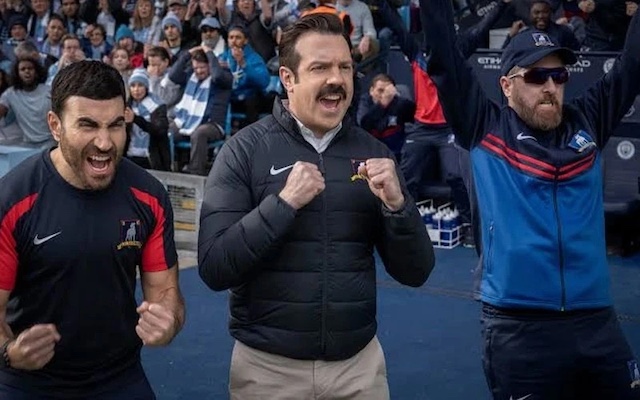Viewers all over the world were (and remain) obsessed with the television show “Ted Lasso” for its feel-good take on the bonds that grow within a workplace. In the show, Ted, a basketball coach from Kansas, is recruited by owner Rebecca, who vengefully wants to tank the Richmond, London soccer team that was once her ex-husband’s. But even though Ted lacks knowledge of the sport, he builds camaraderie and confidence within the coaching staff and the team itself, strengthening them on the field and off. In addition to great entertainment, the show offers takeaways for anyone paying attention that could be useful in a variety of situations, especially for people wanting to become more effective leaders. In this article, we look at the leadership lessons Ted Lasso himself could bring to any organization looking to bolster its workforce.
10 Helpful Ted Lasso Leadership Lessons
1. Lead with positivity
While at first Ted’s positivity in even the most unfortunate situations confuses his colleagues, eventually the power of his approach not only inspires and motivates the team to succeed but also permeates their attitudes and those of their fanbase. This positivity also helps to bond the team, encouraging them to root for one another professionally and personally. With Ted’s example, the players approach challenges with optimism and a willingness to make an effort in the face of adversity and during times of change.
The lesson: Leading with positivity creates more resilient, optimistic, and motivated employees who are willing to go the extra mile.
2. Empathy is key
Some players lack the awareness or know-how to address their problems and ask for help. But Ted shows empathy towards them, making an effort to understand their challenges and concerns. He approaches conflicts among his team by addressing their internal struggles in order to build stronger connections and get to the root of the problems affecting their work and relationships with their teammates.
The lesson: Being empathetic allows leaders to connect with their team on a deeper level and foster a supportive environment and positive company culture. When employees feel supported, they’re better able to manage personal and professional challenges, leading to a more productive workplace.
3. Build trust
Ted doesn’t make promises he can’t keep, but lets his team know that he will always make his best effort, and then follows through. As a result, the team trusts Ted’s coaching and his off-field advice. This trust facilitates openness and communication that enables the players to work together more effectively and efficiently.
The lesson: Trust is essential for effective teamwork and collaboration. By being honest, reliable, and transparent leaders, people can earn the trust of their team members.
4. Embrace vulnerability
Ted recognizes that he’s not the obvious choice as coach for an English soccer team, and knows he has a lot to learn. He’s open about this, even seeking help from both back-office staff and team members alike to get up-to-speed and learn the best way to coach them. As a result, players whose frustrations once resulted in conflict learn to be vulnerable and seek guidance for more productive solutions. He also encourages others to seek help for personal issues, creating the Diamond Dog group for male colleagues to have a safe space to share their emotions.
The lesson: Leaders who are open about their own shortcomings create an environment where team members feel comfortable doing the same. This type of environment fosters a supportive culture where employees are likely to be more loyal and engaged.
5. Listen actively
Ted is a great listener, valuing the perspectives and ideas of his team members. He approaches their ideas with curiosity and is never dismissive of their concerns or problems. As a result, the players know that he is someone they can rely on for thoughtful guidance and leadership.
The lesson: Active listening helps leaders understand their team’s needs and concerns, fostering better communication and collaboration. When people feel heard, they also feel more valued, leading to better employee retention.
6. Celebrate diversity
Richmond is a team with great diversity of backgrounds and experience. Ted embraces these qualities, understanding that each player’s unique qualities strengthen the team. Likewise, the back-office staff, players, and fans recognize and celebrate the differences that make each player special.
The lesson: Celebrating diversity fosters inclusivity, welcomes more varied skill sets and experiences, and creates a more dynamic and innovative team. Photo: Apple TV+
7. Lead by example
Whether Ted is learning the ropes of coaching a soccer team under tremendous pressure, working through a match-day strategy, or facing his team after a difficult loss, Ted leads by example. He demonstrates the values and behaviors he expects from his team and the team recognizes how learning from him helps make their work experience and relationships better.
The lesson: When leaders embody the qualities they wish to see in their team, and those qualities have a positive impact on both the team and the organization, they inspire others to follow suit.
8. Stay resilient
Ted faces numerous setbacks throughout the series—the departure of a star player, betrayal by a former colleague, and game losses—but remains resilient in the face of adversity. He manages to lift up those around him when things seem to be at their lowest point, and communicates the bright side of every challenging situation. Even when the team loses their most important match, Ted’s locker-room speech reminds them all how lucky they are to be able to rely on each other for comfort and support.
The lesson: Resilience is essential for leaders to navigate challenges and inspire their team to persevere. Communicating faith in their team members and demonstrating the ability to bounce back after a blow is vital to managing change in a workplace.
9. Foster a growth mindset
Ted learns and grows throughout the series, from the moment he is met with skepticism upon his arrival in London, through various losses, and in facing his own demons with the help of his therapist. In doing so, and in emphasizing the opportunities that come from what seems like the team’s lowest moments, he encourages his team to adopt a growth mindset, focusing on continuous improvement and learning from failures.
The lesson: Leaders who promote a growth mindset create a culture of adaptability and resilience as employees continually learn, persist after setbacks, and craft innovative solutions to problems.
10. Prioritize team well-being
Ted cares deeply about the well-being of his team members and colleagues, both on and off the field, prioritizing their health and happiness over the game. Whether they’re experiencing professional challenges, heartache, family struggles, or discrimination and hate, he recognizes that supporting team members individually helps AFC Richmond as a whole. By putting their welfare first, the players place their trust in Ted and are loyal to him and the organization.
The lesson: Prioritizing the health and happiness of your team fosters loyalty and commitment, ultimately leading to greater success.
Become a Stronger Leader by Putting Ted Lasso’s Leadership Lessons into Practice
Leadership lessons from Ted Lasso can have an ongoing positive impact on your organization when put into practice. By instilling the importance of empathy, positivity, vulnerability, resilience, and other positive traits of the TV coach into your leadership, your workforce will be stronger, happier, and more loyal to your business.
Are you looking for additional ways to develop leadership within your organization? INTOO offers leadership development programming, including career coaching, workshops, and training specifically designed to strengthen, inspire, and empower both emerging and long-time leaders. Contact us today to learn more.
FAQs
What is the philosophy of Ted Lasso?
Ted Lasso, the lead character of the television series of the same name, has a leadership philosophy centered around positivity, empathy, and resilience. He believes in staying optimistic in the face of adversity, being kind to others—even your opponents or enemies, the importance of supporting your colleagues and greater community, and celebrating the uniqueness of every individual.
Is Ted Lasso a good role model?
Ted Lasso’s leadership style is a great example of one that works well for businesses today. Because Ted sets a positive example, is supportive of his colleagues and team members, is an active listener who is trustworthy, shows vulnerability, and encourages others to grow and learn from mistakes, all who look to him for guidance experience some level of success. His traits, when practiced as a leader in any business, can foster loyalty, motivation, engagement, and resilience at work.
Main photo: Apple TV+
Robyn Kern is a seasoned business writer who has written in the HR, education, technology, and nonprofit spaces. She writes about topics including outplacement, layoffs, career development, internal mobility, candidate experience, succession planning, talent acquisition, and more, with the goal of surfacing workforce trends and educating the HR community on these key topics. Her work has been featured on hrforhr.org and trainingindustry.com.











